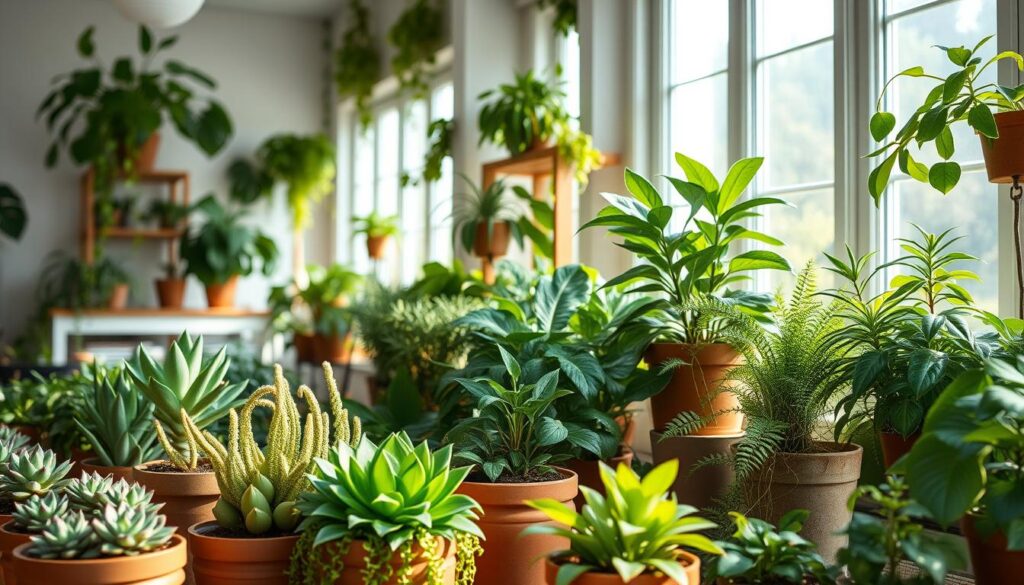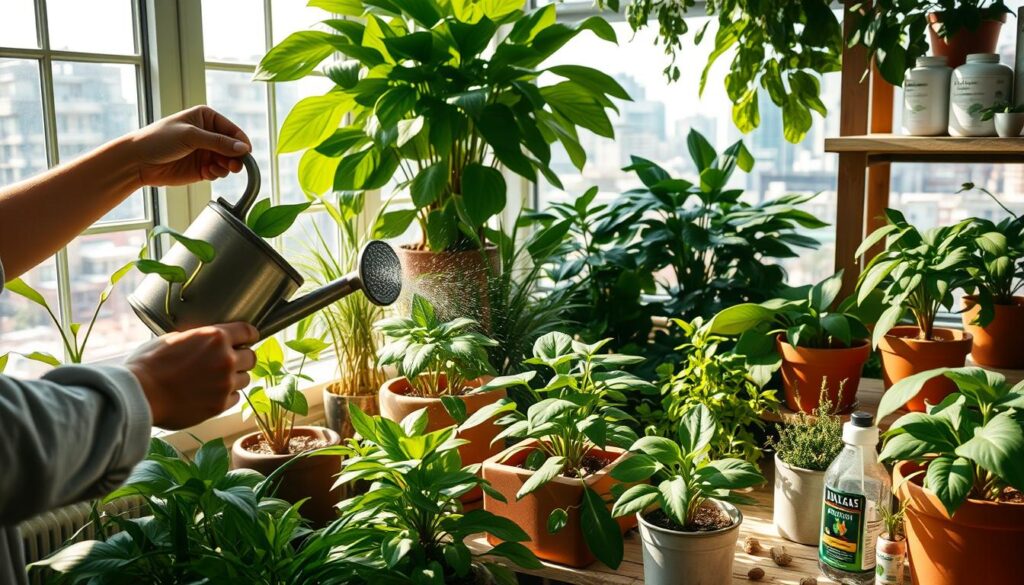In recent years, indoor plant cultivation has become a popular way for people to connect with nature while improving their living spaces. This trend has grown significantly, with many turning to houseplants as a response to environmental concerns. According to BBC News, the rise in houseplant popularity is not just about aesthetics—it’s also about creating a greener, healthier environment indoors.
Rising CO2 levels and temperature fluctuations are impacting both plant growth and gardening practices. These changes challenge indoor gardeners to adapt their techniques. For instance, higher CO2 levels can boost plant growth, but excessive heat can stress plants, making watering and soil management more critical.
The environmental impact of the plant industry itself is another concern. Transportation emissions from importing plants and the use of plastic pots contribute to the carbon footprint. Sustainable practices, like local plant swaps and eco-friendly packaging, are becoming more popular as people seek greener alternatives.
Experts like James Wong and Freddie Blackett emphasize the importance of sustainable gardening. They advocate for using peat-free compost and recyclable pots to reduce environmental impact. By adopting these practices, indoor gardeners can help mitigate climate change while enjoying the benefits of their green spaces.
In this article, we’ll explore practical tips and solutions for eco-friendly indoor plant cultivation. Whether you’re a seasoned gardener or a new enthusiast, you’ll find insights to help you grow thriving plants sustainably. Let’s dive into how you can make a positive impact while nurturing your indoor garden.
Understanding the Effects of Climate Change on Your Indoor Garden
As the world faces environmental shifts, indoor gardens are not immune to the impacts of rising CO2 levels and temperature changes. These factors play a significant role in plant growth and health, presenting both opportunities and challenges for gardeners.
How Rising CO2 and Temperature Impact Plant Growth
Higher CO2 levels can act as a fertilizer, boosting plant growth through a process known as carbon fertilization. However, this can lead to imbalances in nutrient uptake, potentially affecting plant health. Temperature increases also accelerate photosynthesis, but excessive heat can stress plants, complicating soil and water management.
Influences on Water Use and Soil Conditions
Plants in high CO2 environments may experience reduced water loss due to stomatal adjustments, which can affect internal water use efficiency. Warmer temperatures extend growing seasons but may lead to drier soils and altered runoff patterns, impacting soil nutrient availability. Additionally, changing seasons and extreme weather increase the risk of pests and pathogens, further challenging gardeners.
Understanding these dynamics is crucial for maintaining healthy indoor plants amidst a changing environment.
Practical Approaches to Climate Change and Indoor Plant Cultivation
Making eco-friendly choices can significantly reduce the carbon footprint of your indoor garden. By adopting sustainable practices, you not only help the environment but also create a healthier space for your plants to thrive.
Sustainable Practices to Reduce Your Carbon Footprint
One simple yet effective way to make a difference is by reusing plastic pots and choosing locally grown plants. This reduces “plant miles” and cuts down on transportation emissions. Additionally, participating in plant swaps within your community can minimize the need for new resources while fostering connections with fellow gardeners.
Using Eco-Friendly Materials and Packaging
Opting for biodegradable or recyclable packaging is another step toward sustainability. Avoid peat-based composts and instead use peat-free alternatives, which are more environmentally friendly. Retailers like Patch and initiatives like PlantSwap are leading the way in promoting these practices, making it easier for you to join in.
| Material Type | Environmental Impact | Eco-Friendly Alternative |
|---|---|---|
| Plastic Pots | High carbon footprint, non-biodegradable | Recyclable or biodegradable pots |
| Peat-Based Compost | Contributes to peatland degradation | Peat-free compost |
| Single-Use Packaging | Increases landfill waste | Reusable or biodegradable packaging |
Every small change contributes to a greener future. By embracing these sustainable practices, you can enjoy the benefits of indoor gardening while doing your part for the environment.
Getting Started with Sustainable Indoor Plant Cultivation
Starting your journey in sustainable indoor plant cultivation begins with making thoughtful choices about the plants you select and how you care for them. By choosing the right varieties and adopting efficient care practices, you can create a thriving indoor garden that benefits both you and the environment.
Choosing the Right Plant Varieties for Indoor Success
Selecting plants that naturally thrive indoors is key to a successful and sustainable garden. Look for low-maintenance varieties like snake plants or spider plants, which are well-suited to indoor conditions. These plants are not only hardy but also effective at purifying the air, making them a great choice for improving indoor air quality.
When picking plants, consider factors like the amount of light your space receives, the temperature range, and how much room you have available. For example, if your home is bright, a plant like a peace lily might be an excellent option. If you have limited natural light, consider a low-light tolerant plant like a ZZ plant.
Effective Watering and Soil Management Techniques
Watering and soil care are critical for maintaining healthy plants. Overwatering is a common mistake, so it’s important to check the soil moisture before watering. Stick your finger into the soil up to the first knuckle; if the soil feels dry, it’s time to water. If it’s still damp, wait another day or two before watering again.
Using organic additives like compost or well-rotted manure can enhance soil health and promote robust plant growth. These natural amendments provide essential nutrients without the environmental impact of synthetic fertilizers. Additionally, implementing a watering schedule based on the specific needs of your plants can help ensure you’re not over or under-watering.

By following these simple steps, you can create a sustainable indoor garden that not only brings life to your space but also supports a healthier planet.
Innovative Indoor Farming Techniques and Technologies
Indoor farming is evolving rapidly, thanks to cutting-edge technologies that enhance sustainability and efficiency. These innovations are transforming how we grow food, making it possible to produce fresh, high-quality crops year-round while reducing environmental impact.
Leveraging Vertical Farming and Hydroponics
Vertical farming stacks plants in controlled environments, maximizing space and boosting yields. Hydroponic systems, which deliver nutrients directly to roots, use less water and promote faster growth. These methods are ideal for urban areas, where space is limited.
Smart Automation and Controlled Environment Agriculture (CEA)
CEA uses sensors, cameras, and software to monitor and adjust growing conditions. The Bowery Operating System (BoweryOS) optimizes temperature, CO2 levels, and light for each crop, conserving energy and water. Such technologies make farming more efficient and sustainable, reducing the carbon footprint compared to traditional methods.
These innovations are revolutionizing agriculture, offering fresh food year-round while addressing environmental challenges.
Practical Tips for Eco-Friendly Plant Care and Maintenance
Eco-friendly plant care is all about making small, everyday choices that add up to make a big difference. By adopting sustainable practices, you can maintain a thriving indoor garden while reducing your environmental impact.
Minimizing Plastic Use and Avoiding Peat
One of the easiest ways to make your plant care more eco-friendly is by reducing plastic use. Opt for recyclable or reusable pots and materials. For example, instead of buying new plastic pots, consider repurposing old jars or containers you already have at home. This not only reduces waste but also adds a personal touch to your garden.
Local Plant Swaps and Resource Recycling
Engaging in local plant swap events is a great way to refresh your collection sustainably. These events, promoted by initiatives like Kids Against Plastic and PlantSwap, allow you to exchange plants with others in your community, reducing the need for new resources and minimizing transportation emissions. Additionally, recycling household items, such as using cardboard tubes as plant markers, can lower your carbon footprint.

By implementing these simple, everyday actions, you can create a more sustainable indoor garden that benefits both you and the environment. Remember, small consistent efforts can have a significant positive impact over time.
Final Thoughts on Building a Resilient Indoor Garden
Building a resilient indoor garden is a powerful way to promote sustainability while enjoying the beauty of nature in your home. By understanding how factors like rising CO2 levels and temperature changes affect plant growth, you can adapt your gardening techniques to create a thriving environment. Simple actions, such as selecting low-maintenance plants and using eco-friendly materials, can significantly reduce your carbon footprint.
Innovative technologies like vertical farming and smart automation are transforming indoor agriculture, making it more efficient and environmentally responsible. Even small changes, such as efficient watering practices and reducing plastic use, can contribute to a healthier environment. Remember, indoor gardening is not just a hobby—it’s a proactive step toward a greener future.
Embrace sustainable gardening practices and continue exploring new ways to make your indoor garden resilient. Every small effort counts, and together, we can create a positive impact on our planet.
